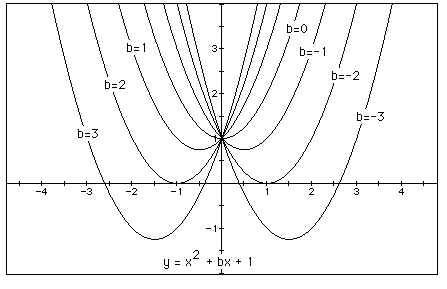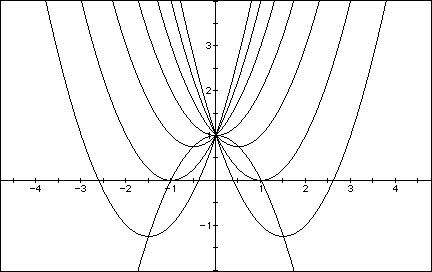
The Department of Mathematics Education

The Department of Mathematics Education
![]()
and to overlay several graphs of
![]()
for different values of a, b, or c as the other two are held constant. From these graphs discussion of the patterns for the roots of
![]()
can be followed. For example, if we set
![]()
for b = -3, -2, -1, 0, 1, 2, 3, and overlay the graphs, the following picture is obtained.

We can discuss the "movement" of a parabola as b is changed. Notice that the parabola always passes through the same point on the y-axis ( the point (0,1) with this equation). For b < -2 the parabola intersects the x-axis in two points which have positive x values (i.e. the original equation has two positive real roots). For b = -2, the parabola is tangent to the positive x-axis and so the original equation has one positive real root at this point of tangency. For -2 < b < 2, the parabola does not intersect the x-axis; therefore, the original equation has no real roots (i.e.the roots are imaginary). Similarly for b = 2, the parabola is tangent to the negative x-axis (one negative real root), and for b 2, the parabola intersets the x-axis twice giving two negative real roots for the original equation.
Now consider the locus of the vertices of the set of parabolas graphed from
![]() .
.
To show that the locus of the vertices is a parabola, we will use the vertex formula. We know that vertex of the parabola
![]()
is given by

Thus, for our case with
The x-coordinate of the vertex is x = -b/2, and the y-coordinate of vertex is determined by



![]()
To do so, we will solve for a in the above equation and get

This is a rational function with a vertical asymptote at x = 0, and a horizontal asymptote at y = 0. If we take any particular value of a, and overlay the equation y = a on the graph, we add a line parallel to the x-axis. If the line intersects the curve in the xa plane the intersection points correspond to the roots of the original equation for those particular values of b. In the following graph horizontal lines at a = 2, 0 < a < 0.25, and a = -2 are shown.

![]()
Find the discriminant, and set it equal to zero

Thus, the only value of a that yields one root for the equation under investigation is a = 1/4.
Therefore, it is clear that the original equation will have
Graphs in the xb plane
Consider the equation
Now, graph this relation in the xb plane. To do so we need to solve for b and get


If we take any particular value of b, say b = 5, and overlay this equation on the graph we add a line parallel to the x-axis. If it intersects the curve in the xb plane, the intersection points correspond to the roots of the original equation for that value of b. Take a look at the following graph:

It is clear on a single graph that the original equation will have:
Now let's explore the case when c = -1, i.e., look at the equation
![]()
The graph of this equation is the red graph.

In this case for any value of b we get two distinct real roots, one positive and one negative.
![]()
is considered. When we solve for c, we will get
![]()
This is graph of a parabola that looks down with vertex at (-5/2, 25/4).
If we take any particular value of c and draw the line, the intersections
of the line and the curve in the xc plane are the roots of the original
equation for that particular value of c.

It is clear from the graph that the original equation will have:
Send email to jwilson@coe.uga.edu
Or Behnaz Rouhani at rouhani@prodigy.net
Return to EMAT 6680 Home Page